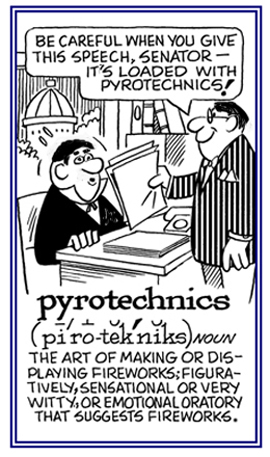-ics, -tics [-ac after i]
(Greek: a suffix that forms nouns and is usually used to form names of arts and sciences)
2. The use of psychological techniques for controlling and modifying human behavior, especially for practical ends.
2. The study of diseases of the dental pulp and their condition following the occurrence of a preceding disease; also endodontics.
Root canal treatment is also known as endodontic therapy. Having a root canal generally involves treatment of the tooth's pulpal tissue (or nerve).
In addition to nerve fibers, the pulpal tissue also contains arteries, veins, lymph vessels, and connective tissue.
Root canals are often the most feared procedure by regular visitors to the dentist's office, although it is claimed to be, in most cases, a fairly uncomplicated and low-pain treatment.
2. Of or relating to solid rock formed from molten rock; igneous.
3. A sensational display of eloquence, wit, anger, etc.: Greg thrilled his audience with his vocal pyrotechnics about how the economy was getting much better!
4. Etymology: borrowed from French pyrotechnique; from Greek and Latin pyro- "fire" + Latin technicus, "technical."

Go to this Word A Day Revisited Index
so you can see more of Mickey Bach's cartoons.
The transcription factor is a protein that binds to specific DNA sequences, and so controlling the movement (or transcription) of genetic information.
2. The use of computer-controlled robots to perform manual tasks; especially, on an assembly line.
2. The study of the relationship between symbols and what they represent.
2. The study of signs and symbols of all kinds, what they mean, and how they relate to the things or ideas they refer to.
With reference to culture, the meaning of a sign or symbol is not permanent an it varies over time, in different contexts, and by the intent of the speaker or writer.
The relationship between a symbol or sign and what it represents can also be challenged by different individuals or groups of individuals who might have different views on the content of a specific sign or signified relationship; such as, with the word "culture".
3. In medicine, the study of symptoms of diseases and identifying the ways that various symptoms indicate the diseases that underlie them."Modern semiotics has produced so many new insights and viewpoints that symbol research is being placed on an increasingly secure foundation."
"In our age of inundation by optical stimuli, there is a great danger that man's own capacity for pictorial thought will continue to languish. Working with symbols can help us find means and ways to see behind things and to tie together visual and verbal manifestations of a world so wonderfully varied and multi-layered."


